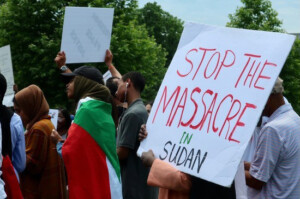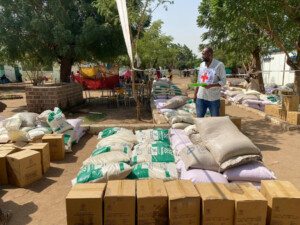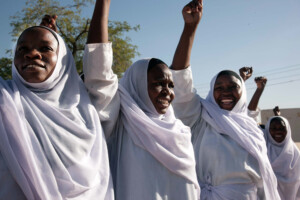Feature: The man beyond Sudan’s iconic protest photo
Few people would pick up a tear gas canister that has been thrown at them. Even fewer are photographed doing so. Today we lift the smoke screen surrounding one of the most iconic photos of the bread price protests in Sudan.
 A version of the iconic protest photo, shared publicly on Facebook (Picture: After original by Anon)
A version of the iconic protest photo, shared publicly on Facebook (Picture: After original by Anon)
Few people would pick up a tear gas canister that has been thrown at them. Even fewer are photographed doing so. Today we lift the smoke screen surrounding one of the most iconic photos of the bread price protests in Sudan.
The man has his arms spread wide. Smoke rises from the back of his djellaba and surrounds him. The image suggests that we are looking at a man who does not heed the source of smoke, or the impression he makes. He seems to be the source of the smoke himself.
He walks in a street in Omdurman, the twin-city of Khartoum, during demonstrations against the government’s financial measures which have had dire consequences on Sudanese people. The image of this man is in the process of becoming an icon for the frequent demonstrations that have taken place this month, which were frequently dispersed by riot police beating demonstrators and firing tear gas.
Tuesday 16 and Wednesday 17 January witnessed several demonstrations in Khartoum and Omdurman and, inevitably, several arrests of journalists and protesters. People have swamped Sudan’s social media platforms with videos, photos and comments on the protests. Especially this photo of the man in smoke gained attention on Facebook and Twitter.
Phyiscal risks
On social media the story behind the photo slowly revealed itself. The man is Yagoub Ahmed Mustafa, a member of the political bureau of the National Umma Party (NUP) and head of the party in Dar El Salam, a locality in North Darfur.
He was at the premises of a school in El Ahliya in Omdurman, where an opposition party held a vigil on January 17. The preceding day, Sudanese authorities had attempted to stop the event and pre-emptively flooded El Ahliya schoolyard with sewage water.
A video of the vigil in Omdurman on Wednesday shows people being hit by riot police (RD)
Riot police fired tear gas cannisters at the crowd. The chemical weapon started to disperse gas which at first would cause severe eye, respiratory, and skin irritation, pain, bleeding, or even blindness, to one standing too close. Because there was a large number of people at the vigil, there were many people at risk.
Tear gas guns cannot adjust their range of fire, causing physical risk to non-targets. According to the Chemical Weapons Convention of 1993, which was signed by almost every nation in the world, tear gas is banned in warfare but legal in domestic riot control. For example Turkey, Bahrain, and police in Ferguson in the USA, have used it to force compliance from demonstrators.

‘Tear gas man’
Yagoub saw two cannisters on the ground and picked them up, using his djellaba to protect his hands from the heat. He put them in his pockets to quickly get them out of the crowd, to limit their effects.
He could have done several things. He could roll the tear gas containers over the ground or cover them with dirt to limit the spread of smoke. But Yagoub chose to carry them out of the mass, threatening his own physical well-being in the act.
The Umma Party member was later seen at the party's headquarters, with holes burnt in his pockets.


On the picture a witness made of him, Yagoub walks alone with active tear gas cans emitting the burning aerosol and burning through his clothes, in order to save others. So it became that he was thankfully called ‘Tear gas man’ on social media. For giving the Omdurman protesters a chance, and for giving the nationwide protests a symbol.
Price hike protests
People have held demonstrations nearly every day this month against the sharp price increases following the higher taxes in Sudan on consumer goods, including flour and fuel, that the new annual budget includes.
In addition to this, the statutory increase in the customs price of the US Dollar from SDG 6.7 to SDG 18 caused a rise in the Dollar exchange rate in the parallel market. The Dollar rate in the black market increased with six Sudanese Pound in less than two weeks.
The new budget has been criticised for allocating the majority of funds to security, defence and presidential expenditures.












 and then
and then